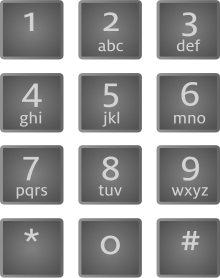Choice of letters
As letters choice (even word choice number or vanity number of English. Vanity : vanity) a method is known, numbers to be represented by sequences of letters.
use
On many telephone keypads, letters from the Latin alphabet are also assigned to the number keys . If these letters are used instead of the digits to represent phone numbers, phone numbers can be represented as memorable terms. Umlauts are thereby formed by two characters: the output vowel and the letter e .
To dial a word choice number, the key assigned to the letter is pressed once, the typed sequence of numbers for a WIKIPEDIA number would be 945473342. Not every word is suitable for this purpose. The length of the phone number can be set to a certain number of characters.
Word dial numbers have been used extensively for service numbers in the United States for several decades. For this reason, letters are or were indexed there on rotary telephones . In Germany they have not yet caught on.
history
The letters have their origin in the names of the switching centers. When switching from switching to self-dialing, the abbreviations of the switching centers were represented by their numbers. The number PEnnsylvania 6-5000 of the New York Telephone Exchange Pennsylvania became the number PE6 5000 or 736 5000 . In Germany, too, when switching to self-dialing, assignment was made easier, but the numbers on the dials only went from A (1) to K (0).
Vanity number in Germany
In Germany , a self-selected number, e.g. B. a vanity number , for value-added services numbers - service services (0180), personal numbers (0700), free telephone services (0800) and premium services (0900) - can be requested from the Federal Network Agency (BNetzA). "Since the Federal Network Agency [basically] does not assign names, but telephone numbers, [... applicants] have to convert the desired name / term [themselves] into the appropriate combination of digits on their application." or which one, the Federal Network Agency does not check.
The first six, seven or eight letters of a (desired) name / term result in a vanity number through alphanumeric conversion, the length of which (number of digits after the service code ) depends on the type of call number. For the number ranges of the value-added services, the following rules apply, from how many digits a vanity number can be formed:
- Numbering Space 0180 : A vanity number is six (without tariff code ) or seven (with tariff identifier) numbers are formed (0180-x-nnnnnn and 0180 nnnnnnn)
- Numbering Space 0700 : A vanity number can be made up of eight digits (0700 nnnnnnnn)
- Numbering Space 0800 : A vanity number can be formed from seven digits (0800 nnnnnnn)
- Numbering Space 0900 : A vanity number can be made up of six digits (0900 nnnnnn)
Web links
Individual evidence
- ↑ Rules for the allocation of (0) 180 numbers. (PDF; 56 kB) Federal Network Agency , March 1, 2010, retrieved on April 29, 2010 : "2.2 Vanity numbers [...] A vanity number for service services can consist of six (without tariff code) or seven (with tariff code) Digits are formed. If the name or term consists of more than six or seven letters, the number is considered a vanity number, the alphanumeric conversion of which corresponds to the first six or seven letters of the name or term. "
- ↑ Rules for the allocation of personal numbers. (No longer available online.) Federal Network Agency , March 1, 2010, archived from the original on May 23, 2010 ; Retrieved on April 29, 2010 : "2.2 Vanity numbers [...] If the name or term consists of more than eight letters, the subscriber number is the vanity number, the alphanumeric conversion of which results in the first eight letters." Info: The archive link was inserted automatically and not yet tested. Please check the original and archive link according to the instructions and then remove this notice.
- ↑ Rules for the allocation of phone numbers for freephone services. (PDF; 51 kB) Federal Network Agency , August 11, 2004, accessed on April 29, 2010 : "2.2 Vanity numbers [...] If the name or term consists of more than seven letters, the subscriber number is the vanity number, its alphanumeric Implementation results in the first seven letters. "
- ↑ Rules for the allocation of phone numbers for premium rate services. (PDF; 73 kB) Federal Network Agency , August 11, 2004, accessed on April 29, 2010 : "2.2 Vanity numbers [...] If the name or term consists of more than six letters, the subscriber number is the vanity number, its alphanumeric Implementation results in the first six letters. "
